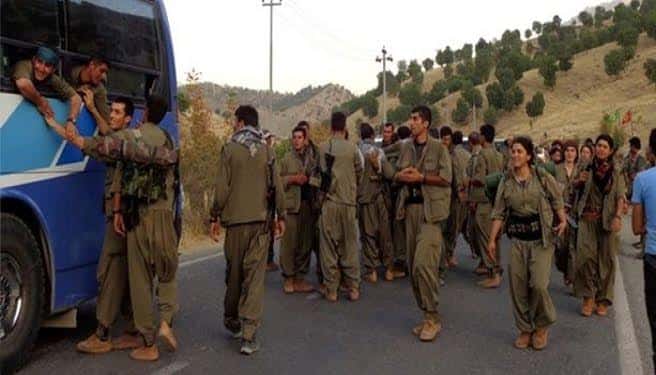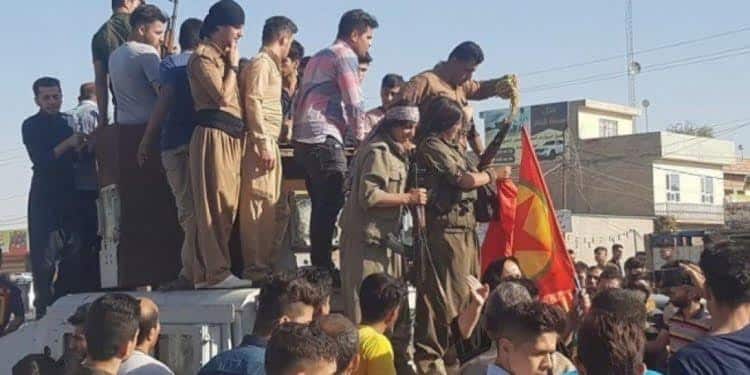The Role of the PKK in Defending Iraq and the Kurdistan Region
02.08.2024
Article by Rojnews (02.07.2024)
In 2014, Iraq and Southern Kurdistan were under the dark shadow of ISIS gangs, and these attacks posed a great threat to the peoples of Iraq and the Kurdistan Region. However, against these dangerous threats, the PKK showed great heroism. The PKK made great sacrifices for the peoples of Iraq and Southern Kurdistan. At that time, the PKK guerrillas were congratulated by the Iraqi government, the parliament, and former Prime Minister Haider al-Abadi.

From Şengal to Hewlêr, Kirkuk, Makhmur, Gulale, and Xurmatû, across thousands of kilometers, the Kurdistan Freedom Guerrillas stood shoulder to shoulder with the Peshmerga to defend Southern Kurdistan, shedding blood and stopping the threat of ISIS.
In 2014, when ISIS gangs occupied Mosul and began their attacks on the territory of the Kurdistan Region, the people of the Kurdistan Region, especially the official authorities and KDP leaders, asked for the support of the PKK to defend Southern Kurdistan.
Turkey Did Not Come to Their Aid
When ISIS gangs began their attacks on Şengal and Makhmur, which were close to Hewlêr, despite the requests from all sides in the Kurdistan Region, the PDK conveyed their request for protection to Turkey to protect Hewlêr. But Turkey did not respond to their request and did not provide any support.
The occupying Turkish state, which sees the KDP as its friend and ally, did not respond to the request and even provided support to ISIS gangs. This was also revealed with evidence and witnesses, and it was publicly disclosed. On the other hand, the PKK guerrillas left the mountains of Kurdistan and went to the front lines to fight against ISIS. At that time, the Kurdistan Regional Government and the political parties in Southern Kurdistan formally asked the PKK to help with the defense of the Region.
According to a private source, at that time, high-level KDP officials, through the head of the KCK Foreign Relations Committee, Şehîd Zekî Şengalî, asked the PKK to join the fight against ISIS with an official announcement. The PKK responded with a statement and announced their support for the defense of the Region.
According to the same sources, the request was made for the guerrillas to enter the towns of Southern Kurdistan with their uniforms, weapons, and flags in a convoy of vehicles to raise the morale of the people. At that time, the guerrillas left Qandil in a large convoy and went to the front lines. From Şengal to Kirkuk, Makhmur, Gulale, and Xurmatû, the guerrillas were welcomed with great enthusiasm by the people.
Guerrillas Went to Celewla
In mid-2014, after ISIS gangs completely took control of the town of Gulale (Celewla), the gangs made their calls for prayer from the mosques. The occupation of Gulale opened the door for ISIS attacks in the Germiyan area and its surroundings. This created a great threat to the entire area. At that time, the PKK guerrillas under the command of Egîd Kelar, went with Peshmerga forces. The guerrilla forces were welcomed by the commander Mehmud Sengawî. Guerrillas and Peshmerga started the liberation attack on Gulale side by side.
One of the guerrillas who played a heroic role in the battle of Gulale was a guerrilla named Mihemed Ebobekir, known as Dêrsim Germiyanî, who was from Germiyan. Guerrilla Dêrsim was martyred in a battle against the occupying Turkish army in the Botan area of Northern Kurdistan on June 29, 2016.
How the Guerrillas became a shield for Kirkuk
After the occupation of Mosul, ISIS gangs directed their attacks towards the cities of Hawija, Telalwerd, and the surroundings of Kirkuk. The aim of the ISIS gangs was to occupy Kirkuk. After the threat of occupation reached Kirkuk, HPG and YJA Star guerrillas moved from Qandil to Kirkuk and took positions alongside the Peshmerga on the front lines. The guerrillas, along with the Peshmerga, were a significant force in the defense of Kirkuk, from the plains of Hawija to Daqoq and Heftexar. In that period, PKK guerrillas played a critical role in the defense of Kirkuk, particularly in protecting the villages of the Kakeyis.
ISIS made their first attempt to occupy Kirkuk at the end of 2014, starting a major attack on a winter night from Telalwerd. In response to the ISIS gangs, YJA Star and HPG guerrillas, along with the Peshmerga, strengthened the defensive lines. A fierce battle continued from late at night until the morning hours. Eventually, the ISIS attack was repelled.
After this resistance, Martyr Lîwa Şêrko Fatih Şiwanî, the Peshmerga commander at the time, emphasized the role of the guerrillas, stating: “If the guerrillas had not held the front lines and fought alongside the Peshmerga in this battle, the threat would have reached Kirkuk.”
On October 21, 2016, nearly 100 ISIS gangs once again infiltrated Kirkuk from several directions. The threat of occupation returned to Kirkuk. The gangs positioned themselves in the neighborhoods of Yekê Hezîran, Esra Mefqudîn, Dumîz, Tisîn, and Hey Eskerî. After this attempt, the guerrillas entered Kirkuk again and, along with the security forces, the Peshmerga, and the self-sacrificing citizens of Kirkuk, fought against the gangs. After a tough battle, the attack was repelled on the same day. As a result of the attack, 72 people were martyred and 200 were wounded.
Şengal
On August 2nd, one day before the ISIS gangs’ attack, 12,000 armed members of the KDP and security forces, following the order of KDP leader Masoud Barzani, left Shengal. They left the Yazidis without protection. During their withdrawal from Shengal, they not only took their own weapons with them but also confiscated many weapons that the Yazidi civilians had acquired for their self-defense.
On August 3, 2014, after the KDP and Iraqi forces fled from Shengal, ISIS gangs brought the 73rd genocide upon the Yazidi people. As a result of the ISIS attack, more than 5,000 Yazidi Kurds were killed, and thousands of women and children fell into the hands of the gangs. They were sold and traded in the markets of Mosul and Raqqa as if they were commodities. Additionally, hundreds of thousands of Yazidis became displaced.
Some of the people who remained in Shengal and fought for their own defense requested weapons from the KDP forces. However, they were not given any weapons.
After the Yazidis were left without a force and weapons, and the KDP and Iraqi forces fled, the ISIS gangs massacred thousands of Yazidi civilians within 24 hours. Thousands were captured. Hundreds of thousands of people fled to Mount Shengal.
Again, the Guerrillas Went answering the call for help
After the city of Mosul fell into the hands of ISIS gangs in June 2014, the Kurdistan Workers’ Party (PKK) sensed the threat approaching Shengal. Therefore, they sent a guerrilla team consisting of 12 members to Shengal. However, at a KDP checkpoint, 3 of these guerrillas were captured, while the remaining 9 guerrillas made it to Shengal.
9 Guerrillas Fought with only one Dushka
On the day of the attack, only 9 HPG guerrillas remained in Shengal to protect the Yazidis, and they did not abandon the Shengal people. These 9 guerrillas fought for an entire night and day with only one Dushka (a type of heavy weapon) and saved hundreds of thousands of Yazidi civilians from genocide. This group of guerrillas organized Yazidi youth in the mountains of Shengal and established defense units. They held their position until the fighters from the YPG and YPJ from Western Kurdistan (Rojava) arrived in Shengal. The fighters opened a humanitarian corridor between Shengal and Western Kurdistan, allowing the people of Shengal to reach safety in Rojava.
Following the call from PKK Executive Committee Member Murad Karayilan, on August 8th, a force of HPG and YJA Star guerrillas set out for Shengal. The guerrilla force reached Mount Shengal and provided support to the locals who were fighting in the mountains, preventing the gangs from advancing to Mount Shengal.

The Campaign to Liberate Shengal
After the establishment of YBŞ and YJŞ in collaboration with HPG and YJA Star guerrillas, a joint force was formed and began liberating the villages of Shengal. The fighters and guerrillas conducted many effective operations against ISIS gangs daily, liberating several villages from their control.
On October 8, 2015, the Shilo Valley operation was launched to liberate Shengal. Most of the villages in Shengal were freed. On November 12 of the same year, the town of Hol, near Hasakah in Rojava, was liberated by YPG and YPJ fighters. The liberation of Hol, which lies between the Rojava and Shengal border, cut off the support that the ISIS gangs had been receiving. Consequently, the ISIS gangs could not resist the operations of the fighters and guerrillas and started withdrawing their forces towards Mosul.
Only the center of Shengal city remained in the hands of the gangs. On November 13, 2015, Iraqi forces and Peshmerga joined HPG and YBŞ guerrillas in the operation to liberate the center of Shengal, resulting in the complete liberation of Shengal.
Mexmûr
After the ISIS forces captured Shengal and carried out mass killings, on August 6, 2014, they launched an attack on Mexmûr.
Hewler (Erbîl) in Danger
After ISIS forces attacked Mexmûr and Gwer, the danger of occupation came on Erbil. Due to the fear of ISIS, hundreds of families fled from within Erbil and sought refuge outside the city.
The guerrillas turned themselves into a shield to protect Hewlêr (Erbîl)
On the same day, the guerrilla forces reached Maxmur to defend the town. On August 8, the journalist Deniz Firat, who was observing the resistance in Maxmur, was martyred in an attack by Islamist gangs. After strong resistance, the Maxmur camp was cleared of the Islamist gangs by the HPC and HPG on August 11. There, for the first time, an attack by the islamist gangs was repelled, causing fear to spread among the gangs in Iraq. At the same time, the area around Maxmur was liberated. As a result of the resistance, Peshmergas also joined after a while and the danger to Hewler was averted.
On September 12, the HPG guerrillas and members of the HPC launched an operation in the Maxmur area. As a result of this operation, many villages were liberated and dozens of ISIS gang members were killed. Three guerrillas named Siyabend Zap, Avesta Harun Firat and Diyar Şerewî were martyred in these battles. 40 days after the Camp was liberated, the inhabitants of the camp returned to their homes.
When the pages of history are opened, we see that the guerrillas of the HPG fought and shed their blood on the fronts of the war against the gangs of the Islamic State from Shengal to Kerkuk, Mexmur, Gulale and Xurmatûyê, over a distance of a thousand kilometers and defended Southern Kurdistan and Iraq against occupation.
The historical heroism of the PKK guerrillas has been sown in the memory of the Kurdish people and has not been forgotten. On all desperate days, the PKK has reached the people and made itself a shield of freedom for them. Without ever thinking about themselves, the freedom guerrillas have made great sacrifices for the sake of Iraq and the Kurdistan Region.
